
Beginning of the End is a 1957 American science fiction film produced and directed by Bert I. Gordon. It stars Peter Graves, Peggie Castle, and Morris Ankrum. An agricultural scientist, played by Graves, successfully grows gigantic vegetables using radiation. Unfortunately, the vegetables are eaten by locusts, which quickly grow to a gigantic size and attack the nearby city of Chicago. Beginning of the End is generally known for its "atrocious" special effects, "and yet," writes reviewer Bill Warren, "there is something almost compellingly watchable about this goofy little movie".
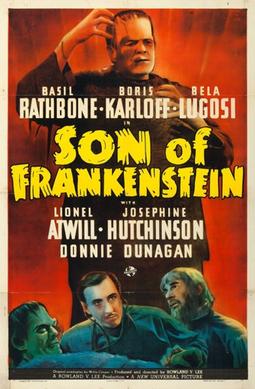
Son of Frankenstein is a 1939 American horror film directed by Rowland V. Lee and starring Basil Rathbone, Boris Karloff and Bela Lugosi. The film is the third in Universal Pictures' Frankenstein series and is the follow-up to the 1935 film Bride of Frankenstein. Son of Frankenstein stars Rathbone as Baron Wolf von Frankenstein who, with his wife Elsa and son Peter, returns to his late father's estate. Near the castle lives Ygor, a crazed blacksmith whose neck was broken in an unsuccessful hanging attempt. Among the castle's remains, Frankenstein discovers the remains of the Monster and decides to try to save his family name by resurrecting the creature to prove his father was correct. He finds, however, the Monster only responds to Ygor's commands.

Corridors of Blood is a 1958 British-American period drama film directed by Robert Day and starring Boris Karloff and Christopher Lee. It was written by Jean Scott Rogers. The original music score was composed by Buxton Orr.

The Black Castle is a 1952 American historical gothic horror film directed by Nathan H. Juran and starring Richard Greene, Boris Karloff, Stephen McNally, Rita Corday and Lon Chaney Jr. It was produced by William Alland. The film was made in the United States but premiered in Sweden.

Macabre is a 1958 American horror film directed by William Castle, written by Robb White, and starring William Prince and Jim Backus. The film falls into both the horror and suspense genres.
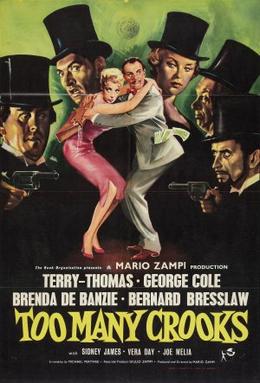
Too Many Crooks is a 1959 British black comedy film directed by Mario Zampi and starring Terry-Thomas, George Cole, Brenda De Banzie, Sidney James, Bernard Bresslaw and Vera Day. It was written by Michael Pertwee and Christiane Rochefort from a story by Jean Nery.

Dry Rot is a 1956 British comedy film directed by Maurice Elvey, and starring Ronald Shiner, Brian Rix, Peggy Mount, and Sid James. The screenplay is by John Chapman, adapted from his 1954 Whitehall farce of the same name.
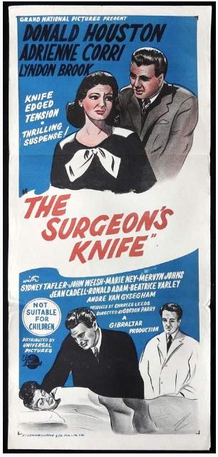
The Surgeon's Knife is a 1957 British crime film directed by Gordon Parry and starring Donald Houston, Adrienne Corri and Lyndon Brook. It was written by Robert Westerby, adapted from 1940 novel The Wicked Flee by Anne Hocking.

Blind Man's Bluff is a 1952 British 'B' crime film directed by Charles Saunders and starring Zena Marshall, Sydney Tafler, and Anthony Pendrell. It was written by John Gilling.
Three Steps to the Gallows is a 1953 British second feature crime film directed by John Gilling and starring Scott Brady, Mary Castle and Gabrielle Brune. It was written by Paul Erickson and Gilling, and released in the US by Lippert Pictures as White Fire.
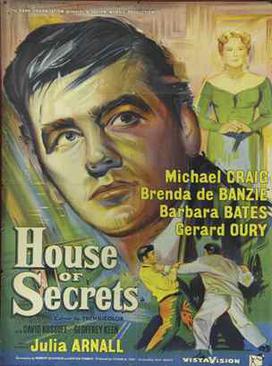
House of Secrets, also known as Triple Deception, is a 1956 British crime thriller film directed by Guy Green and starring Michael Craig, Anton Diffring and Gérard Oury. It was wrirtten by Robert Buckner andBryan Forbes based on the 1955 novel Storm Over Paris by Sterling Noel.
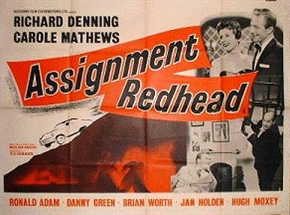
Assignment Redhead is a 1956 British crime thriller film written and directed by Maclean Rogers. It is based on the novel Requiem for a Redhead by Lindsay Hardy.

The Headless Ghost is a 1959 British comedy horror film, produced by Herman Cohen and directed by Peter Graham Scott. It stars Richard Lyon, Liliane Sottane, David Rose, and Clive Revill. The films tells of three young people who spend the night in a haunted English castle. With the help of a friendly ghost, they reunite the head of the Headless Ghost with its body, thus ending its 600 years of wandering about headless. The film was made specifically as the second feature for an American double bill with Horrors of the Black Museum (1959).
Amalgamated Productions was a film company established by Richard Gordon in association with Charles F. "Chuck" Vetter, Jr., in the 1950s. They made a series of films in England. The first seven were crime films mostly using American stars and stories transplanted to England.
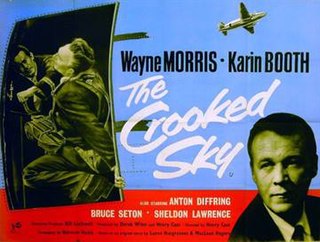
The Crooked Sky is a low budget 1957 black and white British melodrama/crime film, directed by Henry Cass from a story by Maclean Rogers and Charles F. Vetter. The film stars Wayne Morris, Anton Diffring and Karin Booth.

Man in the Shadow is a 1957 British second feature ('B') crime film directed by Montgomery Tully and starring Zachary Scott and Faith Domergue. It was written by Maisie Sharman.

The Big Chance is a 1957 black and white British second feature ('B') drama film directed by Peter Graham Scott and starring Adrienne Corri, William Russell, and Ian Colin. It was written by Scott and Barbara S. Harper.
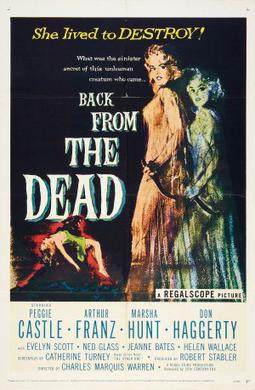
Back from the Dead is a black and white 1957 American horror film produced by Robert Stabler and directed by Charles Marquis Warren for Regal Films. The film stars Peggie Castle, Arthur Franz, Marsha Hunt and Don Haggerty. The narrative concerns a young woman who, under the influence of a devil cult, is possessed by the spirit of her husband's first wife, who had died six years earlier. The screenplay was written by Catherine Turney from her novel The Other One. The film was released theatrically on August 12, 1957, by 20th Century Fox on a double bill with The Unknown Terror.

Counterspy is a 1953 British second feature comedy thriller film directed by Vernon Sewell and starring Dermot Walsh, Hazel Court and Hermione Baddeley. An accountant comes into possession of secret papers sought by both the government and a spy ring.

There Was a Young Lady is a 1953 British comedy film directed by Lawrence Huntington and starring Michael Denison, Dulcie Gray and Sydney Tafler. It was made at Walton Studios and on location in London. The film's sets were designed by the art director Frederick Pusey. Huntington had been a prominent director in the 1940s but after this film he dropped into making second features. The film marked the screen debut of Geraldine McEwan.


















